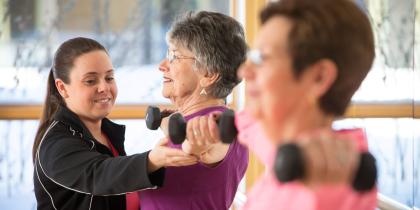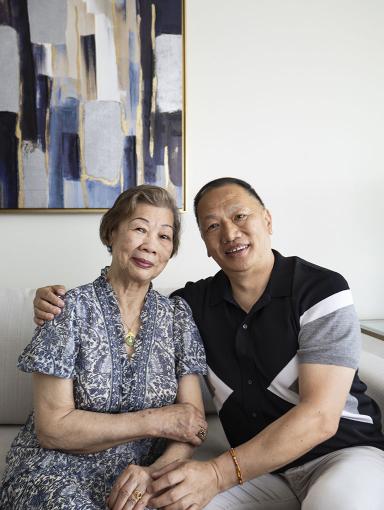Aging Strong: Why Strength Training Is Essential for Older Adults
Read about strength training’s crucial role in preventing age-related muscle loss.

Living independently at home for longer. Getting up from your chair steadier and with ease. Playing with your grandchildren. Bringing in groceries from your car without pain. Reducing your fear of falling.
What do these things have in common? All have the power to improve your quality of life, and all are benefits you might experience if you decide to take up strength training!
In the media, strength training is often discussed in the context of bulking up or getting a “beach-ready” body. But that messaging is unrealistic, frequently targets young adults, and fails to explain how strength training keeps you healthy as you age. Strength training runs much deeper than achieving a preferred body type. It can help you spend quality time with your loved ones, complete activities of daily living, and live without fear.
Why prioritize strength training?
Strength training involves physical exercises that improve muscle strength by making your muscles work against a weight or resistance. You can use equipment like weights, exercise machines, resistance bands, or even your own body weight.
The impact that strength training can have on your life is monumental. I’ve seen it time and time again in my 35 years at Hebrew Rehabilitation Center, where we facilitate an exercise program designed just for seniors run by exercise physiologists who specialize in fitness for older adults.
Strength training reduces age-related muscle loss
Sarcopenia is the loss of muscle mass and strength as you age. Losing muscle mass as you age is typical — after age 30, you begin to lose 3% to 5% of your muscle mass per decade. The National Institute on Aging’s Baltimore Longitudinal Study of Aging found that muscle power declines even faster after age 65 for women and age 70 for men. Research has also found that sarcopenia in older adults is a risk factor for falls and fractures and is associated with a lower quality of life.
While a certain level of muscle loss is a typical part of the aging process, that doesn’t mean you can’t do anything to slow it down or reduce its impact on your life. So, what can you do to prevent this decline? Take a “use it or lose it” approach — use your muscles!
Maintaining muscle strength can reduce your risk of falls and fractures and help you better manage everyday activities requiring strength. Picking up groceries, opening car doors, climbing stairs, and more all require muscle strength you don’t think about until you have difficulty doing them.
Other key health benefits
Older adults can have many other conditions that may benefit from strength training. Strength training can:
- Reduce your risk of osteoporosis by increasing your bone density
- Support and protect your joints and ease pain and stiffness if you have osteoarthritis
- Improve cardiovascular health in adults with and without heart disease
- Help your body use insulin more efficiently and improve blood glucose control
- Improve your mental health and reduce symptoms of depression
Barriers that prevent older adults from strength training
While the benefits of strength training for older adults are undeniable, many people who would benefit from it are holding back. While everyone has their reasons, there are a few common barriers that hold older adults back from starting this form of exercise:
Misconceptions about what you are capable of
In 1994, Hebrew SeniorLife’s research institute published a study that defied widespread assumptions about what older adults could do. We conducted a 10-week high-intensity resistance training program in nursing home residents with frailty and found that their muscle strength, mobility, and spontaneous physical activity improved. Four participants who used walkers at the beginning of the program switched to canes by the end, and participants’ overall ability to get up from chairs improved significantly.
One of the most groundbreaking parts of the study was that the average participant was 87 years old! Ours was one of the first studies to disprove the ageist assumption that adults in their 80s and older cannot safely exercise.
Thirty years have passed since then, and much more research has shown that strength training is safe for older adults. One meta-analysis of 41 articles found that older adults with cognitive impairment benefit from strength and endurance training when participating in exercise trials and rehabilitation programs and have similar outcomes to participants without cognitive impairment.
But there’s still progress to be made. In 2020, a literature review on ageism in the health and fitness industry revealed that ageism can hold older adults back from engaging in physical activity. Ageism can be self-imposed, meaning it’s a thought or belief you have about yourself that holds you back. However, it found that older adults experience ageism from others even more often. For example, a fitness instructor may only prescribe mild-intensity exercise to older adults because of incorrect and ageist assumptions about what they’re capable of doing.
Fear that movement will exacerbate an existing injury
Fear is another one of the biggest reasons older adults don't exercise. You may associate physical activity with pain if you have a chronic health condition or chronic pain. You may have pushed yourself past your limits in the past, exacerbating an issue and making you scared to try it again. If you feel unsteady on your feet, you may be scared that doing something like going on a walk will cause you to fall. As a result, you choose to stay at home or in your chair instead of exercising.
That can leave you stuck in a negative feedback loop — your fear of pain or injury causes you not to start an exercise program, but a sedentary lifestyle may be making your pain, discomfort, or imbalance worse.
You deserve to live your life to the fullest! But that doesn’t mean you need to jump into a routine that could harm you. If you haven’t exercised in a while and feel trapped in a cycle of fear, physical therapy could be an excellent option to get you back on your feet again.
A physical therapist can help you gain strength without pushing you too much or too little. Your muscles, range of motion, and confidence can grow before you try strength training outside a supervised environment. Ask your primary care physician about a physical therapy referral if you think that’s a good option.
Getting started
Let’s say you don’t need physical therapy or have finished your program. What should you do? Supervised exercise programs are a fantastic option for older adults who want to begin strength training safely!
Hebrew Rehabilitation Center’s Get Up & Go exercise program involves a comprehensive fitness evaluation by exercise physiologists specializing in fitness for older adults. They will then develop a personalized exercise program made just for you! Get Up & Go, which focuses on progressive strength training, balance, and endurance or cardiovascular training, stands as a testament that people in their 80s and beyond can join an exercise program and thrive.
If you’d prefer to try out exercises at home, check out our blog post that offers exercise plan tips for seniors, including advice on strength exercises. You can also watch the video below featuring Chris Young, fitness manager at Orchard Cove in Canton, MA. He demonstrates three bodyweight exercises you can do at home using only a chair.
Kickstart your fitness journey at Hebrew SeniorLife
Are you interested in discovering how our personalized exercise program can benefit you? Contact us online or call 617-363-8284 today to learn more about Get Up & Go.
Blog Topics
Learn More
Senior Fitness
Our exercise physiologists specialize in fitness for older adults and will develop a personalized exercise program for you.




